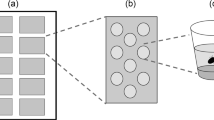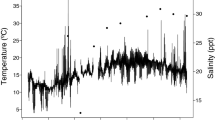Abstract
Global climate change affects aquatic habitats in a number of ways that pose challenges for aquatic insect populations. Increasing water temperature and corresponding decreases in dissolved oxygen can impact respiratory behaviors, even in air-breathing aquatic taxa. Crawling water beetles (Coleoptera: Haliplidae) exhibit a combined respiratory strategy that employs an air store that is periodically replenished at the water surface. The frequency at which beetles surface to replenish the bubble is determined both by oxygen demand and by the capacity of the air store to uptake oxygen from the surrounding water via diffusion. However, little is known of how changes in water temperature and dissolved oxygen will affect submersion time. We investigated this question in Peltodytes callosus, a species of crawling water beetle that is widely distributed across the American West. We manipulated temperature and dissolved oxygen to mimic changes associated with global climate change and recorded the time between surfacing events. We found that beetles stayed submerged for shorter durations in response to both increasing water temperature and decreasing dissolved oxygen. Our results suggest that beetles may be able to modify their surfacing behavior to respond to climate-induced changes in water quality.




Similar content being viewed by others
References
Bates D, Maechler M, Bolker BM (2011) lme4: linear mixed-effects models using S4 classes. In, R package version 0.999375–42
Boersma KS, Bogan MT, Henrichs BA, Lytle DA (2014) Top predator removals have consistent effects on large species despite high environmental variability. Oikos 123:807–816
Boersma KS, Lytle DA (2014) Overland dispersal and drought-escape behavior in a flightless aquatic insect, Abedus herberti (Hemiptera: Belostomatidae). Southwest Nat 59:301–302
Bogan MT (2017) Hurry up and wait: life cycle and distribution of an intermittent stream specialist (Mesocapnia arizonensis). Freshw Sci 36:805–815
Calosi P (2012) The comparative biology of diving in two genera of European Dytiscidae (Coleoptera). J Evol Biol 25:329–341
Calosi P, Bilton DT, Spicer JI (2007) The diving response of a diving beetle: effects of temperature and acidification. J Zool 273:289–297
Calosi P, Bilton DT, Spicer JI (2008) Thermal tolerance, acclimatory capacity and vulnerability to global climate change. Biol Lett 4:99–102
Chaui-Berlinck JG, Bicudo JEPW, Monteiro LHA (2001) The oxygen gain of diving insects. Respir physiol 128:229–233
Contreras HL, Bradley TJ (2011) The effect of ambient humidity and metabolic rate on the gas-exchange pattern of the semi-aquatic insect Aquarius remigis. J Exp Biol 214:1086–1091
Cook BI, Smerdon JE, Seager R, Coats S (2014) Global warming and 21st century drying. Clim Dyn 43:2607–2627
Cover MR, Seo JH, Resh VH (2015) Life history, burrowing behavior, and distribution of Neohermes filicornis (Megaloptera: Corydalidae), a long-lived aquatic insect in intermittent streams. West North Am Nat 75:474–490
Crump ML (1983) Opportunistic cannibalism by amphibian larvae in temporary aquatic environments. Am Nat 121:281–289
De Ruiter L, Wolvekamp HP, van Tooren AJ (1949) Experiments on the respiration of some aquatic insects (Hydrous piceus L., Naucoris cimicoides L. and Notonecta glauca L.). Acta Physiol Pharmacol Neerlandica 1:657–659
Durfee RS, Knight Jasper S, Kondratieff BC (2005) Colorado Haliplidae (Coleoptera): biogeography and identification. J Kansas Entomol Soc 78:41–70
Gillooly JF, Brown JH, West GB, Savage VM, Charnov EL (2001) Effects of size and temperature on metabolic rate. Science 293:2248–2251
Greig HS, Wissinger SA, McIntosh AR (2013) Top-down control of prey increases with drying disturbance in ponds: a consequence of non-consumptive interactions? J Anim Ecol 82:598–607
Hickman JR (1931a) Contribution to the biology of the Haliplidae (Coleoptera). Ann Entomol Soc Am 24:129–142
Hickman JR (1931b) Respiration of the Haliplidae (Coleoptera). Papers of the Michigan Academy of Science, Arts and Letters 8:277–289
Kehl S, Dettner K (2009) Surviving submerged: setal tracheal gills for gas exchange in adult rheophilic diving beetles. J Morphol 270:1348–1355
Lake PS (2003) Ecological effects of perturbation by drought in flowing waters. Freshw Biol 48:1161–1172
Lenth RV (2016) Least-squares means: the R package lsmeans. J Stat Softw 69:1–33
Madsen BL (2012) Submersion respiration in small diving beetles (Dytiscidae). Aquat Insects 34:57–76
Mas-Martí E, García-Berthou E, Sabater S, Tomanova S, Munoz I (2010) Comparing fish assemblages and trophic ecology of permanent and intermittent reaches in a Mediterranean stream. Hydrobiologia 657:167–180
Matheson R (1912) The Haliplidæ of North America, North of Mexico. J N Y Entomol Soc 20:156–193
Merritt RW, Cummins KW, Berg MB (2008) An introduction to the aquatic Insects of North America. Kendell/Hunt, Dubuque, IA
R Core Team (2014) R: a language and environment for statistical computing. R Foundation for Statistical Computing, Vienna, Austria. http://www.R-project.org/
Roberts CH (1913) Critical notes on the species of Haliplidae of America north of Mexico with descriptions of new species. J N Y Entomol Soc 21:91–123
Ruff TW, Kushnir Y, Seager R (2011) Comparing twentieth- and twenty-first-century patterns of interannual precipitation variability over the western United States and northern Mexico. J Hydrometeorol 13:366–378
Seager R, Ting M, Held I, Kushnir Y, Lu J, Vecchi G, Huang H-P, Harnik N, Leetmaa A, Lau N-C, Li C, Velez J, Naik N (2007) Model projections of an imminent transition to a more arid climate in southwestern North America. Science 316:1181–1184
Seager R, Ting M, Li C, Naik N, Cook B, Nakamura J, Liu H (2013) Projections of declining surface-water availability for the southwestern United States. Nat Clim Chang 3:482–486
Seymour RS, Matthews PG (2013) Physical gills in diving insects and spiders: theory and experiment. J Exp Biol 216:164–170
Therneau T (2015) A package for Survival Analysis in S. Version 2.38
Verberk WCEP, Bilton DT (2014) Respiratory control in aquatic insects dictates their vulnerability to global warming. Biol Lett 9:20130473
Verberk WCEP, Bilton DT, Calosi P, Spicer JI (2011) Oxygen supply in aquatic ectotherms: partial pressure and solubility together explain biodiversity and size patterns. Ecology 92:1565–1572
Wańkowski JWJ, Thorpe JE (1979) Spatial distribution and feeding in Atlantic salmon, Salmo salar L. juveniles. J Fish Biol 14:239–247
Acknowledgements
We are grateful to S Brudzinski, L Patrick, and R Paulson for logistical support during this project and to MT Bogan for useful feedback on an earlier version of this manuscript.
Author information
Authors and Affiliations
Corresponding author
Rights and permissions
About this article
Cite this article
Banks, T.B., Kincaid, R.M. & Boersma, K.S. Temperature and Dissolved Oxygen Determine Submersion Time in Aquatic Beetle Peltodytes callosus (Coleoptera: Haliplidae). J Insect Behav 31, 427–435 (2018). https://doi.org/10.1007/s10905-018-9689-6
Received:
Revised:
Accepted:
Published:
Issue Date:
DOI: https://doi.org/10.1007/s10905-018-9689-6




